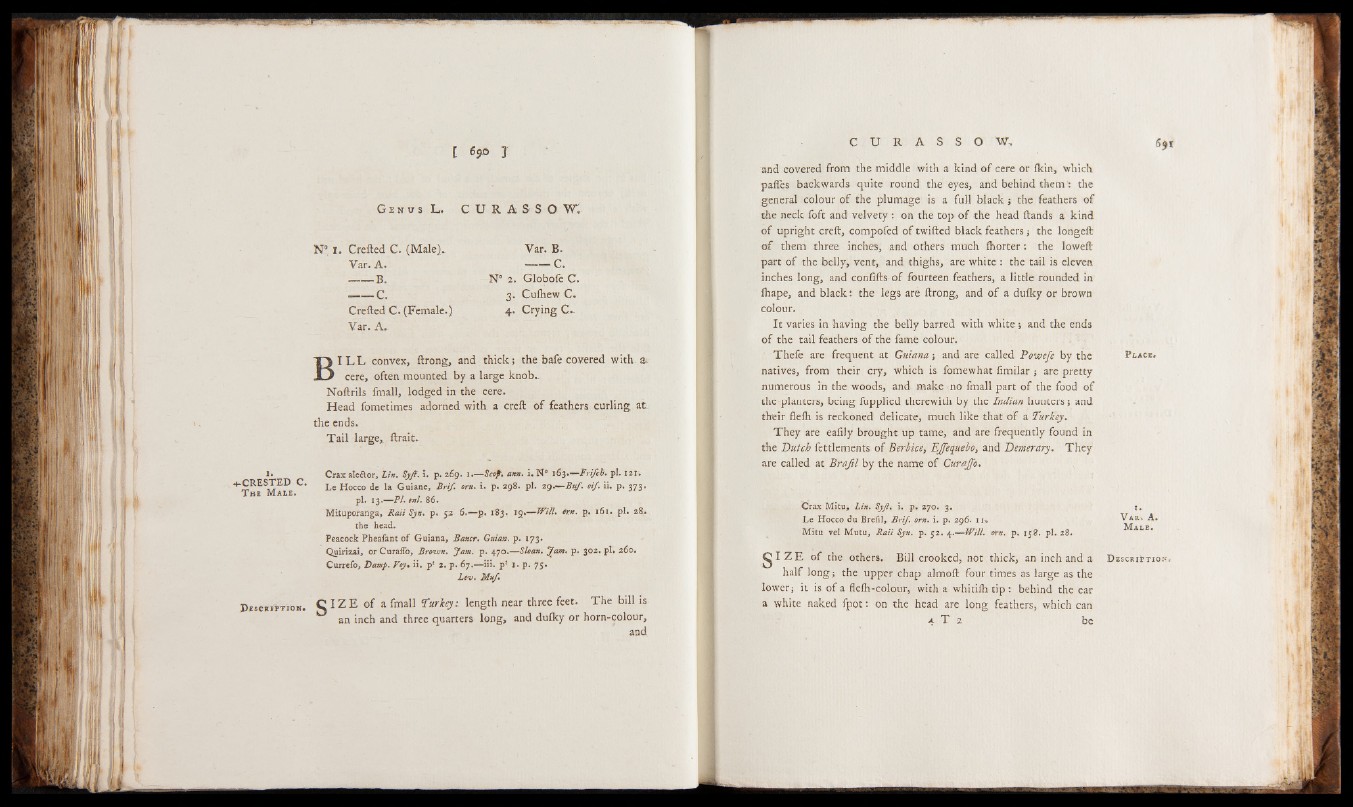
[ 6 9° I
4-CRESTED c .
T he Male.
G e n u s L. C U R A S S O \V.
N“ I. Crefted C. (Male).
Var. A.
------B.
------C.
Crefted C. (Female.)
Yar. A ,
Var. B.
------C.
N° 2. Globofe C.
3. Culhew C.
4. Crying CB
I L L convex, ftrong, and thick; the bafe covered with. &
cere, often mounted by a large knob*.
Noftrils fmall, lodged in the cere.
Head fometimes adorned with a creft of feathers curling at.
the ends.
Tail large* flrait..
Crax aleftor, Lin. Syjf. i. p. 269. 1.— Scof. amt. i. N° 163.—/'rifcb. pi. 121;
Le Hocco de la Guiane, Brif. orn. i. p. 298. pi. 29.— Buf. oif. ii. p. 373.
pi. 13.— PI. enl. 86.
Mituporanga, Raii Syn. p. 52 6.— p. 183. 19.— Will. tr.n. p. 161. pi. 28.
the head.
Peacock Pheafant of Guiana, Bancr. Guian. p. 173.
Quirizai, or Curaflo, Brown. Jam. p. 470.— Sloan. Jam. p. 302. pi# 260.
Currefo, Damp. Voy. ii. p‘ 2. p. 67.—iii. pl x. p. 75.
Lev. MvJ*
C I Z E of a fmall Turkeyi length near three feet. The bill is
an inch and three quarters long, and dulky or horn-colour,
and
J)ESCK»tTrÖN.
and covered from the middle with a kind of cere or (kin, which
paffes backwards quite round the eyes, and behind them : the
general colour of the plumage is a full black; the feathers of
the neck foft and velvety : on the top of the head ftands a kind
of upright creft, compofed of twifted black feathers; the longed;
of them three inches, and others much (horter: the lowed
part of the belly, vent, and thighs, are white : the tail is eleven
inches long, and confifts of fourteen feathers, a little rounded in
lhape, and black: the legs are ftrong, and of a dufky or brown
colour.
It varies in having the belly barred with white ; and the ends
of the tail feathers of the fame colour.
Thefe are frequent at Guiana; and are called Powefe by the P lace.
natives, from their cry, which is fomewhat limilar; are pretty
numerous in the woods, and make no fmall part of the food of
the planters, being fupplied therewith by the Indian hunters; and
their flefh is reckoned delicate, much like that of a Turkey.
They are ealily brought up tame, and are frequently found in
the Dutch fettlements of Berbice, EJfequebo, and Demerary. They
are called at Brajil by the name of Curajjo.
Crax Mitu, Lin. Syß. i. p. 270. 3. 1.
Le Hocco du Brefil, Brif. orn. i. p. 296. n> V ar. A.
Mitu vel Mutu, Rail Syn. p. 32. 4.—Will. orn. p. 158. pl. 28.
g l Z E of the others. Bill crooked, not thick, an inch and a DEscRitriot',
half long; the upper chap almoft four times as large as the
lower; it is of a fle(h-colour, with a whitilh tip; behind the ear
a white naked fpot: on the head are long feathers, which can
4 T 2 be